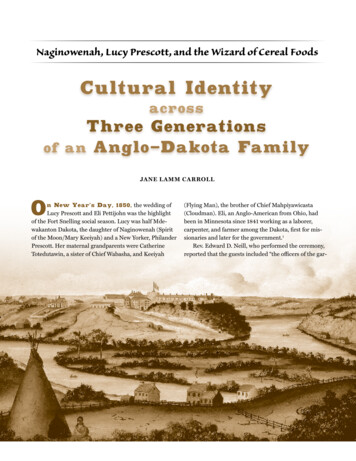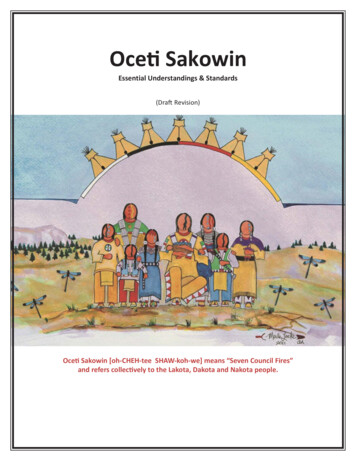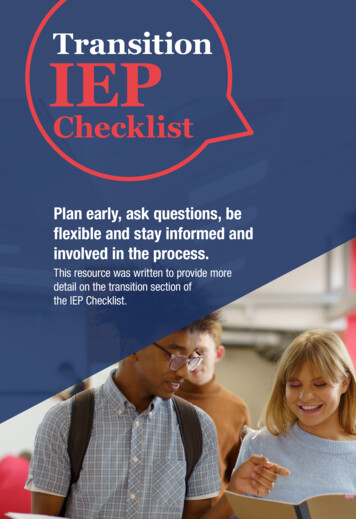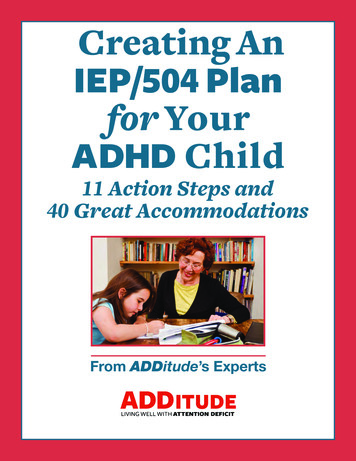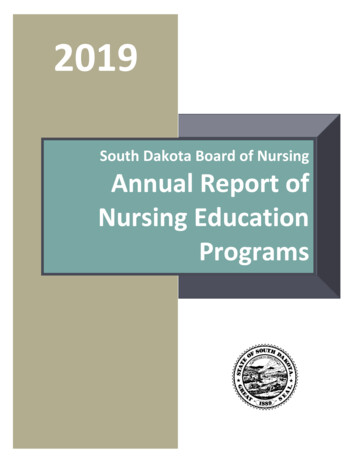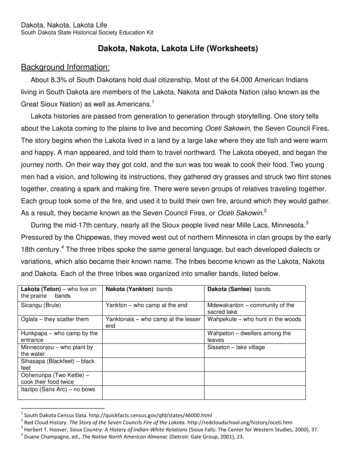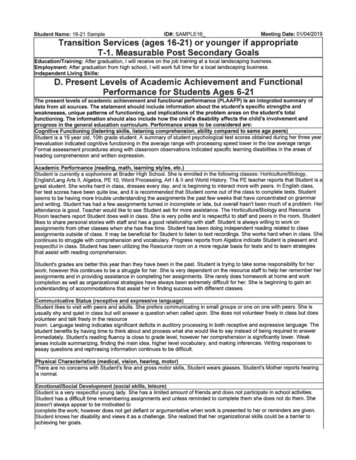
Transcription
Student Name: 16-21 SampleID#: SAMPLE1 6Meeting Date: 01/04/2019Transition Services (ages 16-21) or younger if appropriateT-1. Measurable Post Secondary GoalsEducation/Training: After graduation, I will receive on the job training at a local landscaping business.Employment: After graduation from high school, I will work full time for a local landscaping business.Independent Living Skills:D. Present Levels of Academic Achievement and FunctionalPerformance for Students Ages 6-21The present levels of academic achievement and functional performance (PLAAFP) is an Integrated summary ofdata from all sources. The statement should include information about the student's specific strengths andweaknesses, unique patterns of functioning, and implications of the problem areas on the student's totalfunctioning. The information should also include how the child's disability affects the child's involvement and!Progress in the general education curriculum. Performance areas to be considered are:Cognitive Functioning (listening skills, listening comprehension, ability compared to same age peers)Student is a 16 year old, 10th grade student. A summary of student psychological test scores obtained during her three yearreevaluation indicated cognitive functioning in the average range with processing speed lower in the low average range.Formal assessment procedures along with classroom observations indicated specific learning disabilities in the areas ofreading comprehension and written expression.[Academic Performance (reading, math, learning styles, etc.)Student is currently a sophomore at Brader High School. She is enrolled in the following classes: Horticulture/Biology,English/Lang Arts II, Algebra, PE 10, Word Processing, Art I & II and World History. The PE teacher reports that Student is agreat student. She works hard in class, dresses every day, and is beginning to interact more with peers. In English class,her test scores have been quite low, and it is recommended that Student come out of the class to complete tests. Studentseems to be having more trouble understanding the assignments the past few weeks that have concentrated on grammarand writing. Student has had a few assignments turned in incomplete or late, but overall hasn't been much of a problem . Heratten dance is good . Teacher would like to see Student ask for more assistance. The Horticulture/Biology and ResourceRoom teachers report Student does well In class. She is very polite and is respectful to staff and peers in the room. Studentlikes to share personal stories with staff and has a good relationship with staff. Student is always willing to work onassignments from other classes when she has free time. Student has been doing independent reading related to classassignments outside of class. It may be beneficial for Student to listen to text recordings. She works hard when in class. Shecontinues to struggle with comprehension and vocabulary. Progress reports from Algebra indicate Student is pleasant andrespectful in class. Student has been utilizing the Resource room on a more regular basis for tests and to learn strategiesthat assist with reading comprehension .Student's grades are better this year than they have been in the past. Student is trying to take some responsibility for herwork; however this continues to be a struggle for her. She is very dependent on the resource staff to help her remember herassignments and in providing assistance in completing her assignments. She rarely does homework at home and workcompletion as well as organizational strategies have always been extremely difficult for her. She is beginning to gain anunderstanding of accommodations that assist her in finding success with different classes.Communicative Status (receptive and expressive language)Student likes to visit with peers and adults. She prefers communicating in small groups or one on one with peers . She isusually shy and quiet in class but will answer a question when called upon. She does not volunteer freely in class but doesvolunteer and talk freely in the resourceroom . Language testing indicates significant deficits in auditory processing in both receptive and expressive language. Thestudent benefits by having time to think about and process what she would like to say instead of being required to answerimmediately. Student's reading fluency is close to grade level, however her comprehension is significantly lower. Weakareas include summarizing , finding the main idea, higher level vocabulary, and making inferences. Writing responses toessay questions and rephrasing information continues to be difficult.Physical Characteristics (medical, vision, hearing, motor)There are no concerns with Student's fine and gross motor skills, Student wears glasses. Student's Mother reports hearingis normal.Emotional/Social Development (social skills, leisure)Student is a very respectful young lady. She has a limited amount of friends and does not participate in school activities.Student has a difficult time remembering assignments and unless reminded to complete them she does not do them. Shedoesn't always appear to be motivated tocomplete the work; however does not get defiant or argumentative when work is presented to her or reminders are given.Student knows her disability and views it as a challenge. She realized that her organizational skills could be a barrier toachieving her goals.
Student is friendly and pleasant to peers and staff. Her choice of topics for conversation can be seen as immature at times.Studen.t's attendance has improved from last year.Adaptive Characteristics (including adaptive behavior, self care, independent living, self direction, health andsafetv. work)Student's behaviors both in school and out in the community are appropriate.Ecological Factors (functional skills and community participation, home/family, neighborhood)Student resides at home with mother. Student enjoys doing yard work, planting flowers and trees in the summer. Studentassits with snowremoval work in the winter. She enjoys decorating the house with holiday lights and decorations.OtherAddress the present level of performance in each of the following domains with documentation of student needs,preferences and interests and identify by what method this information was obtained. )Jobs and Job TrainingWhile completing the Student Transition Inventory, Student indicated that she enjoys doing yard work and had earnedmoney doing ard work for neighbors. She especially enjoys planting and weeding flowers. Student has trimmed branchesfrom trees and enjoys doing that also. Student has great interest in landscaping and is hoping to find summer employmentin this area. Student's mother indicates that Student has always had an interest in yard work and takes pride in the work shedoes.Student completed the TPI and indicated that she knows how to look for a job, but has concerns with her ability to fill out anapplication. She indicated that it would be important for her to stay focused on good work habits and to be willing to takeadvice and ask questions from thoseshe is working with in order to stay employed once she has a job.On the ESTRS, Student scored herself proficient (36 out of 62) in the area of employment. Areas of significant need include:understanding factors which influence job retention, dismissal and promotion, demonstrating skills necessary to performsuccessfully in a job interview,understanding information on a paycheck and accurately completing a job application.By what method was this obtained:High school Student Transition Interview (Completed by Teacher and Student) 2018Enderle Severson Transition Rating Scale (ESTRS) (Completed by Student, Parent, and Teacher) 2019[Transition planning Inventory (TPI) (Completed by Student and Teacher) 2018ACT PLAN 2019Recreation and LeisureAccording to information obtained from the ESTR areas of significant need in the recreation/leisure area are: initiatinginteractions with peers, attending activities outside the home by initiating involvement in rec/leisure activities.Mother indicates that she has seen improvement in Student's interactions with friends. Student does invite some of herneighbors over to play games and watch tv but they are not peers her age.While completing the Student Transition Interview, Student stated that she does not participate in many recreation activitieswith friends, but does like to attend functions with her relatives. She ahs attended various church activities, county fairs,horse shows, and parades.Studentenjoys communicating with adults more than her peers. She adds they seem more accepting of her. She is able to find herway around town and act appropriate in public situations.By what method was this obtained:High School Student Transition Interview (Completed by Student and Teacher) 2018Enderle Severson Transition Rating Scale. (ESTR) (Completed by student and Teacher) 2019Home/Independent LivingAccording to the Transition Planning Inventory (TPI) , teacher, and parent observations, Student demonstrates appropriatehygiene, dresses appropriately according to the weather, and wears appropriate clothing to school. Student indicated that itwould be difficult for her to find aplace to live, but felt she could do it. She has moved a couple of times, so noted she would be able to pack, move, and setup a place. She enjoys doing household tasks and likes a clean home. Student does not have a driver's license but hopes toget it this year. Student would like to learn to use an Uber or a taxi as another mode of transportation.
bn the ESTR, areas of significant need identified were performing written correspondence, demonstrating necessary skills o manage a checking account, understanding basic parenting skills and demonstrating skills to plan a simple budget. Theseneed areas are quite typical for a student at Student's grade level.lhformation from the High School Student Transition Interview and the School and Community Social Skills Rating Checklistndlcated that student usually has good manners and respects materials and belongings in her home and community. Sheiaccepts consequences for wrong doing andresponds to authorities. She knows how to treat minor illnesses but isn't always sure when medical care is needed. Studentconsistently noted that she lacks understanding of checking accounts, paying bills and learning to budget.By what method was this obtained:High School Student Transition Inventory (Completed by Student and Teacher) 2018Parent ObservationEnderle Severson Transition Rating Scale (ESTR} (Completed by Student and Teacher) 2019Transition Planning Interview (TPI) (Completed by Student and Teacher) 2018School and Community Social Skills Rating Checklist 2019Community ParticipationAccording to the ESTRS, Student identified the following areas of need: obtaining a drivers license, identifying agencies thatcan provide support and assistance, understanding charge accounts and loans, and practicing comparative shopping .These are all areas that will beadd ressed while student is in high school and are areas of need for many students at this grade level.iThrough completion of the Student Transition Interview, the School and Community Social Skills Rating Checklist and theITPI , it was evident that Student has a clear understanding of where things are in her community, knows how to stay clear ofstrangers, exhibits good audiencebehaviors, knows how to respond to emergency situations. Student and parent reported that Student needs assistance inasking for directions in public.By what method was this obtained:Enderle Severson Transition Rating Scale (ESTRS) (Completed by Parent, Student, and Teacher) 2019Transition Planning Inventory (TPI) (Completed by Studentt and Teacher) 2018School and Community Social Skills Rating Checklist 2019High School Student Transition Inventory (Completed by Student and Teacher) 2018Post-Secondary Training and Learning OpportunitiesStudent's rating on the ESTRS in the area of Post Secondary Education was quite low. This is not concerning at this pointhowever as Student is only a Sophomore and many of the items on this rating scale do not pertain to her. This is becauseStudent does not plan to go on to college or trade school. Student clearly understands what her interest area is. Student hasvisited and will continue to visit with the school counselor to establish courses and experiences that will enable her to becareer ready upon graduation.By what method was this obtained:Informal student interview 2019Enderle Severson Transition Rating Scale (Completed by Student and Teacher) 2019Related ServicesNo related services at this time.By what method was this obtained:None at this time.
Studen t Name: 16-21 SampI eID# : SAMPLE1 6Meet'm g Date: 01/04/2019T -2. Course of velList Courses and Educational Experiences tobe taken each yearPhysical Science (1)General Math (1)English I (1)Ninth grade Global Studies (1)Keyboarding (1)Foods (1/2)PE 9 (1/2)English II (1)World History (1)Horticulture/Biology (1)Algebra (1)Tenth gradeWord Processing (1/2)Art I (1/2)Art II (1/2)PE10(1/2)Advanced Biology (1)US History (1)Work Experience (1)EleventhPE 11 (1/2)gradeDriver's Ed (1/2)Geometry (1)English Ill (1)GovernmenUCivics (1)English IV (1)Food of the World ( 1/2)TwelfthHealth (1/2)gradeCareer & Tech (1)Work Experience (1)Credits to beearnedCreditsEarnedTotal CreditsEarned666665Ages 18-21Total Number of credits required by this district for graduation: 22Anticipated month and year of graduation: May 2021Will this student exit secondary school with fewer credits than required of all students by the district?Yes NoDIf yes, identify the alternate document approved by the district that the student will receive.Transfer of Rights:No later than one year before the age of majority (18) the student and family must be informed of the educational transfer ofrights.Discussion of transfer of rights must be held and documentation here.Transfer of rights were discussed at IEP meeting held 12/4/17.Date of IEP Meeting when transfer of rights was discussed 07/09/2018Procedural Safeguards:Upon turning 18, the student and parent must receive written notification that the educational rights of the student havetransferred.Date transfer of rights to students occurred and "Transfer of Rights to Student" form was signed, if applicable
Student Name: 16-21 SampleID#: SAMPLE16Meeting Date: 01/04/2019T -3. Transition ServicesStrategies and Activities Needed to Assist the Student in ReachingPost-Secondary GoalsEducation/Training:Goal: After qraduation, I will receive on the job trainlnq at a local landscaping business.ActivityParticipate ingroup with socialworker todevelopstrategies fordevelopingfriendships andself-awareness.Monitor ated Adult DailyEmploymentService Living chool socialworker andStudentAugust 2020 toDecember 2020 Case Mangerand StudentJanuary 2019 toJanuary 2020 D Employment:Goal: After graduation from high school , I will work full time for a local landscaping nstructionCommunityRelated Adult DailyEmploymentExperiencesService Living LivingFuneVoeAssessJob shadow 2landscapingbusinessesStudent, CaseManager andSchoolCounselorJanuary 2019 toJanuary 2020 Complete 3different jobapplicationsStudent, CaseManagerJanuary 2019 toJune 2019 D D
Student Name: 16-21 Sam leAnnual Goal # 1 of 2 goalsID#: SAMPLE16Meeting Date: 01/04/2019F. Annual Goals, Short-Term Objectives, and Periodic review ofservicesReference From North Dakota English Language Arts Content Stds 2017Grade/Subject Standard 2: Students engage in the reading process.Strand: 10.2.1 INFORMATIONAL GENRES: Summarize information from nonfiction genres.Annual GoalIntent/purpose:Student will become successful in her education/trainingBehavior:Student will improve her reading comprehension abilitiesEnding Level:by learning reading comprehension strategies, such as the scanning, skimming and summarizing strategy, to increasecomprehension skills from a level of 3 correct out of 10 to a level 7 correct out of 10 over 3 consecutive collection pointsCharacteristics of services:Specially designed instruction taught in a small group settingHow and when periodic progress reports will be provided:Written progress will be reported quarterlyWill a graph be used to report progress toward the annual goal and associated objectives?DYes No
Student Name: 16-21 Sample!Annual Goal # 2 of 2 goalsID#: SAMPLE16Meeting Date: 01/04/2019F. Annual Goals, Short-Term Objectives, and Periodic review ofservicesAnnual GoalIntent/purpose:To prepare for the transition out of high school and into a career related to landscapingBehavior:Student will research landscaping careersEnding Level:and identify five potential types of jobs that require landscaping skills and interests.Characteristics of services:Specialized instruction provided by the school counselor and Case Manager. Completed career and job reports will beplaced by Student in hertransition portfolio.How and when periodic progress reports will be provided:Progress will be reported quarterlyWill a graph be used to report progress toward the annual goal and associated objectives?DYes No
Student Name: 16-21 Sample ID#: SAMPLE16 Meeting Date: 01/04/2019 Transition Services (ages 16-21) or younger if appropriate T-1. Measurable Post Secondary Goals Education/Training: After graduation, I will receive on the job training at a local landscaping business. Employment: After graduation from high school
